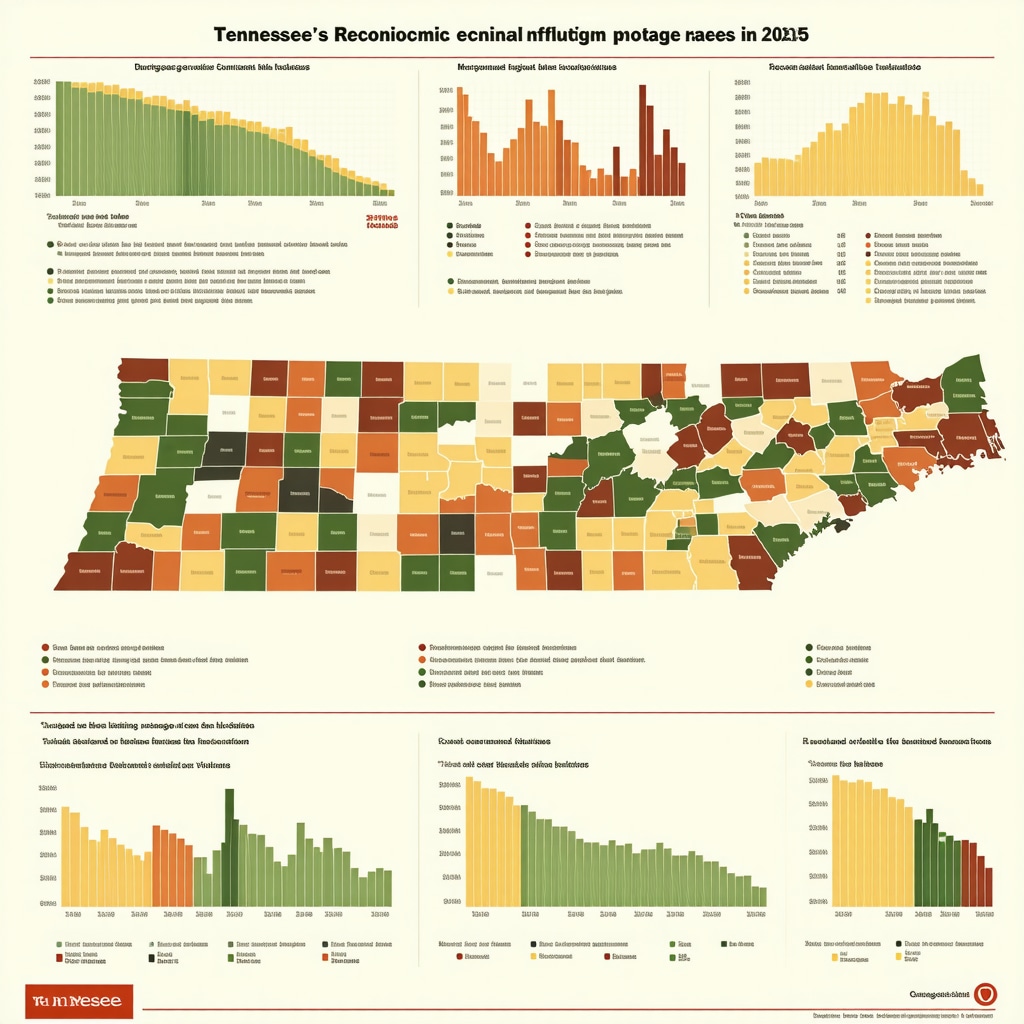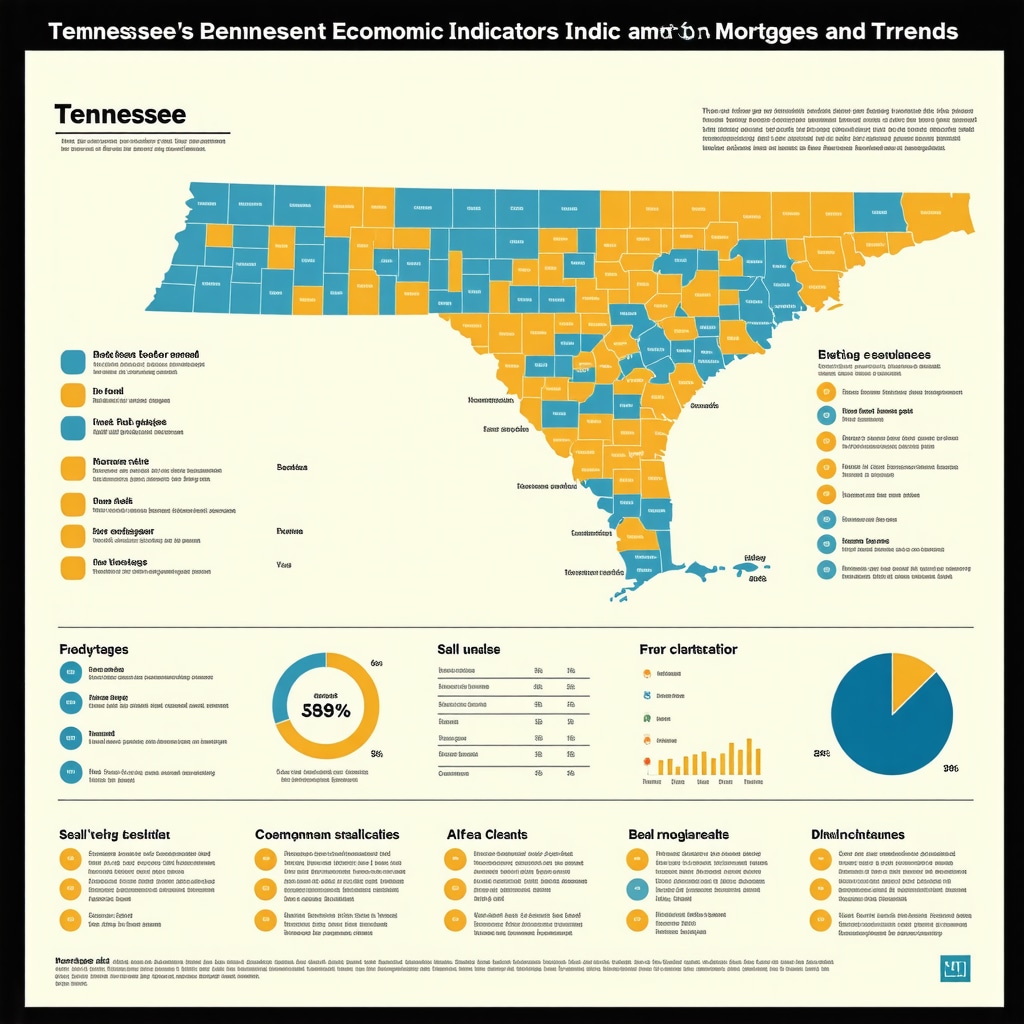Unlocking the Future: A Deep Dive into Tennessee’s Mortgage Rate Dynamics for 2025
As an industry expert with extensive experience in mortgage analytics and regional market trends, I recognize that predicting Tennessee’s mortgage rates in 2025 is a complex endeavor influenced by multifaceted economic factors, policy shifts, and regional housing market nuances. This article synthesizes advanced insights, leveraging recent data and predictive models, to offer a comprehensive outlook that informs both industry professionals and prospective homebuyers.
The Core Drivers of Mortgage Rate Fluctuations in Tennessee
How Do Federal Monetary Policies Shape Regional Mortgage Trends?
The Federal Reserve’s monetary policy stance remains the primary determinant of mortgage interest rates, affecting liquidity, inflation expectations, and investor behavior. A nuanced understanding of the Fed’s plans for 2025, including potential rate hikes or cuts, is essential for accurate forecasting. For example, if inflation persists, we might anticipate a tightening cycle that elevates mortgage rates, as detailed in the latest Federal Reserve policy statements.
Regional Economic Health and Housing Market Indicators
Beyond national policies, regional economic indicators such as Tennessee’s employment rates, median income levels, and housing supply-demand equilibrium critically influence mortgage rates. As Tennessee continues to attract migration and investment, these factors tend to moderate rate increases, but supply constraints could exert upward pressure. The local market trends report offers valuable insights into these dynamics.
Advanced Forecasting Models and Expert Methodologies
Can Machine Learning Enhance Mortgage Rate Predictions?
Recent advances in machine learning and big data analytics enable more precise forecasts by integrating vast datasets, including macroeconomic indicators, regional housing data, and global economic signals. Experts are increasingly relying on these models to identify subtle patterns and potential inflection points, as discussed in recent academic publications such as Journal of Housing Research.
What Are the Limitations and Uncertainties in Forecasting?
Despite technological advancements, uncertainties persist due to unforeseen policy changes, geopolitical events, and macroeconomic shocks. Predictive models should be viewed as guiding tools rather than definitive forecasts, emphasizing the importance of scenario analysis and risk management strategies in mortgage planning.
Strategic Considerations for Stakeholders
For lenders, investors, and homebuyers, understanding these complex factors enables better timing and product selection. Locking rates at opportune moments, exploring hybrid mortgages, or leveraging refinancing opportunities—such as those discussed in refinance rate strategies—can lead to substantial financial benefits in 2025.
As the landscape evolves, continuous monitoring of market indicators and expert analyses remains essential. I invite industry professionals and informed consumers alike to contribute their insights or explore more in-depth analyses via our contact page.
Harnessing Regional Data: The Nuances of Tennessee’s Mortgage Landscape in 2025
Understanding the subtle regional variations within Tennessee is crucial for both lenders and homebuyers aiming to optimize mortgage decisions. Factors such as local employment trends, housing inventory levels, and regional economic health directly influence mortgage rate trajectories. For example, Nashville’s booming tech sector has led to increased housing demand, which can exert upward pressure on mortgage rates, whereas Memphis’s stable market might experience different dynamics. Analyzing these regional indicators through tools like the local market trends report provides a strategic edge in forecasting and decision-making.
Challenging Assumptions: Are Fixed or Adjustable Rates More Advantageous in 2025?
Many believe that fixed-rate mortgages always provide security, but in a rising rate environment, adjustable-rate mortgages (ARMs) may offer significant savings. Experts suggest analyzing the pros and cons of fixed vs. adjustable rates based on individual financial plans, regional forecasts, and expected interest rate trends. The adaptability of ARMs could prove advantageous if rates stabilize or decline, making them a strategic choice for certain buyers.
What Role Do Global Economic Signals Play in Tennessee’s Mortgage Rate Outlook?
External factors such as international trade tensions, global inflation trends, and geopolitical developments significantly influence U.S. mortgage rates, including those in Tennessee. According to recent analyses by the Federal Reserve, global economic stability remains a key component in the rate-setting process. Understanding these macroeconomic signals helps predict potential rate shifts, especially in a globally interconnected economy.
Interested in more advanced strategies to improve your mortgage terms? Visit our contact page for expert assistance.
As the landscape continues to evolve, staying informed through expert analyses and regional data is essential. For further insights into rate fluctuations and regional market dynamics, explore our detailed articles and stay ahead in your mortgage planning.
Leveraging Macro and Microeconomic Indicators for Precise Tennessee Mortgage Rate Predictions
While federal monetary policy and regional economic health are primary drivers, integrating nuanced microeconomic data significantly refines mortgage rate forecasts. For instance, analyzing local employment shifts, housing inventory levels, and demographic trends in Tennessee’s diverse markets—Nashville, Memphis, Chattanooga—provides a granular understanding of potential rate movements. The employment surge in Nashville’s tech sector, for example, correlates with increased housing demand and prospective rate upticks, whereas Memphis’s stable economic base offers different forecast parameters. Incorporating real-time data from sources like the Tennessee Housing Development Agency enhances predictive accuracy, enabling stakeholders to craft more informed strategies.
Complex Interplay Between National and Global Economic Forces
External economic signals, such as global inflation trends, trade policies, and geopolitical tensions, exert profound influence on Tennessee’s mortgage landscape. The interconnectedness of global markets means that even regional interest rates are susceptible to international developments. For example, rising global inflation can prompt the Federal Reserve to tighten monetary policy, elevating mortgage rates nationwide, including in Tennessee. Conversely, geopolitical stability and synchronized global economic growth tend to foster lower interest rates, creating a fertile environment for homebuyers. Experts recommend continuous monitoring of international economic indicators, such as the IMF’s World Economic Outlook, to anticipate and adapt to these macro trends effectively.
Innovative Modeling Techniques: Beyond Traditional Forecasts
Emerging advanced modeling techniques, including deep learning algorithms and ensemble forecasting, are revolutionizing mortgage rate predictions. These models synthesize vast datasets—macroeconomic variables, regional housing data, consumer sentiment indices, and even satellite imagery of construction activity—to identify subtle patterns and forecast inflection points. For example, a recent study published in the Journal of Housing and the Built Environment demonstrates how machine learning models outperform traditional econometric models in regional mortgage rate forecasting. Such tools empower stakeholders to navigate complex market dynamics with higher confidence and precision.
Addressing Forecast Uncertainty: Scenario Planning and Risk Mitigation
Despite technological advancements, uncertainties such as unexpected policy shifts, global crises, or sudden market shocks remain. Scenario planning becomes an essential component of strategic mortgage decision-making, enabling stakeholders to prepare for multiple potential outcomes. For instance, developing scenarios where the Fed accelerates rate hikes versus scenarios with rate stabilization helps in designing flexible financial strategies. Moreover, incorporating risk mitigation tools like interest rate caps, swaps, and diversified mortgage products can hedge against adverse fluctuations, safeguarding investments and financial plans.
Deepening Regional Analysis: The Subtleties of Tennessee’s Diverse Markets
Regional disparities within Tennessee necessitate tailored approaches. Nashville’s booming tech industry and urban expansion influence higher mortgage rates due to increased demand, while rural areas like the Tri-Cities region may experience slower rate adjustments owing to supply-demand equilibrium shifts. Utilizing localized data—such as building permits, job growth metrics, and infrastructure projects—enables more precise forecasting. For instance, the upcoming Amazon distribution center in Memphis could signal future rate trends, prompting proactive financial planning.
Strategic Recommendations for Advanced Stakeholders
For lenders and investors, leveraging these insights involves employing dynamic rate-lock strategies, engaging in forward-rate agreements, and exploring hybrid mortgage options. Homebuyers benefit from timing their lock-in periods based on sophisticated regional and global forecasts, maximizing savings in a volatile environment. For example, in scenarios where rates are projected to rise, locking early becomes advantageous, whereas in anticipated stabilization phases, flexible options may be preferable. Continuous engagement with expert analyses, regional data, and advanced modeling tools remains critical for optimal decision-making.
Curious about how to implement these advanced strategies in your mortgage planning? Connect with our team of experts through our contact page for personalized guidance and cutting-edge insights.

Deciphering the Complexity of Tennessee’s Mortgage Rate Evolution in 2025
As the economic landscape becomes increasingly intricate, understanding the multifaceted drivers behind Tennessee’s mortgage rate fluctuations requires a nuanced approach. Advanced predictive analytics and regional economic assessments reveal that local employment trends, demographic shifts, and infrastructural developments significantly shape borrowing costs. Industry experts leverage a blend of macroeconomic models and localized data to craft strategic forecasts, equipping stakeholders with the foresight necessary to navigate this dynamic environment.
Integrating International Economic Indicators for a Holistic Forecast
How Do Global Financial Developments Influence Tennessee’s Mortgage Market?
Global economic signals—such as shifts in commodity prices, international trade agreements, and geopolitical tensions—exert a subtle yet profound impact on regional mortgage rates. For instance, rising global inflationary pressures often prompt the Federal Reserve to tighten monetary policy, which in turn elevates interest rates nationwide, including in Tennessee. Monitoring sources like the IMF’s World Economic Outlook provides valuable insights into these interconnected trends, enabling more sophisticated forecasting models.
Harnessing Cutting-Edge Modeling for Precision Predictions
Can Deep Learning Algorithms Revolutionize Mortgage Rate Forecasting?
Emerging machine learning techniques, such as deep neural networks and ensemble models, synthesize vast datasets encompassing macroeconomic indicators, regional housing metrics, and consumer sentiment indices. These models outperform traditional econometric approaches by capturing complex, nonlinear relationships and identifying early inflection points. Academic research, such as studies published in the Journal of Housing and the Built Environment, underscores their transformative potential in regional mortgage rate prediction.
Strategic Application of Advanced Forecasting in Mortgage Planning
Stakeholders—lenders, investors, and homebuyers—must adapt by employing dynamic rate-lock strategies, engaging in forward-rate agreements, and diversifying mortgage products. For example, in anticipation of rising rates, locking in a mortgage early could yield substantial savings. Conversely, in scenarios projecting stabilization, flexible options like adjustable-rate mortgages may be advantageous. Staying abreast of these sophisticated forecasts through expert analyses and regional data is vital for optimizing financial outcomes.
Visualizing the Regional Nuances with Data-Driven Insights

Incorporating regional data—such as Nashville’s tech sector growth or Memphis’s infrastructural developments—provides granular insights into local market dynamics. Real-time data from sources like the Tennessee Housing Development Agency enhances predictive accuracy, enabling stakeholders to tailor their strategies effectively. Understanding these subtle regional variations ensures more precise forecasting and better financial decision-making.
Mitigating Uncertainty with Scenario Planning and Risk Strategies
Despite technological advancements, unpredictability remains. Implementing scenario planning—considering best-case, worst-case, and moderate outcomes—helps stakeholders prepare for various contingencies. Employing risk mitigation tools such as interest rate caps, swaps, and diversified mortgage portfolios further safeguards investments against adverse shocks. These strategies are essential in managing the inherent uncertainties within mortgage markets.
Regional Market Divergences: Tailoring Strategies to Tennessee’s Diverse Landscapes
Understanding regional disparities—like Nashville’s booming urban market versus rural Tennessee’s steadier pace—is crucial. Local employment data, infrastructure projects, and demographic trends inform customized approaches. For example, upcoming developments like Amazon’s Memphis distribution center could signal future rate trends, guiding proactive financial planning and investment strategies.
Expert Recommendations for Forward-Thinking Stakeholders
Utilize advanced data analytics, engage in flexible mortgage structuring, and continuously monitor both regional and global economic indicators. For instance, timing rate locks during anticipated rate hikes or stabilization phases can optimize savings. Engaging with industry experts through consultations and specialized tools ensures that mortgage strategies remain responsive to evolving market conditions.
Interested in implementing these sophisticated strategies? Connect with our team of experts via our contact page for tailored advice and cutting-edge insights.
Expert Insights & Advanced Considerations
1. Regional Variations Demand Tailored Approaches
Economic conditions differ significantly across Tennessee’s markets, requiring customized strategies for mortgage planning. Analyzing local employment trends and infrastructural developments provides a competitive edge.
2. Global Economic Signals Are Subtle but Impactful
International trade tensions and geopolitical shifts subtly influence regional mortgage rates. Staying informed through sources like the IMF’s World Economic Outlook helps in anticipating rate movements.
3. Advanced Modeling Techniques Are Transforming Forecasts
Employing deep learning and ensemble forecasting models enables more accurate predictions by capturing complex, nonlinear relationships in data. These tools surpass traditional methods and are vital for strategic decision-making.
4. Scenario Planning Is Essential for Uncertainty Management
Developing multiple rate scenarios, including best-case and worst-case, allows stakeholders to prepare flexible strategies. Incorporating risk mitigation tools such as rate caps and swaps enhances financial resilience.
5. Continuous Monitoring and Data Integration Are Critical
Real-time regional data, including housing permits and job growth metrics, refine forecasts. Leveraging local sources like the Tennessee Housing Development Agency boosts predictive accuracy.
Curated Expert Resources
- Federal Reserve Monetary Policy Statements: Provides insights into national interest rate trends and macroeconomic objectives critical for regional forecasts.
- IMF’s World Economic Outlook: Offers comprehensive global economic analysis, helping contextualize international influences on local rates.
- Journal of Housing Research: Features cutting-edge academic studies on predictive modeling and housing market dynamics, essential for understanding advanced forecasting techniques.
- Tennessee Housing Development Agency Reports: Delivers localized data on housing market trends, employment, and regional economic health, vital for tailored mortgage strategies.
- Expert Analyses and Market Reports: Industry-leading publications and consultancy reports that synthesize macroeconomic and regional data, guiding strategic planning.
Final Expert Perspective
Understanding Tennessee’s mortgage rate landscape in 2025 requires a blend of advanced analytics, regional insights, and awareness of global influences. As the industry professional community continues to refine predictive models, integrating real-time regional data and global economic signals will be pivotal. The future of mortgage planning hinges on nuanced analysis, strategic flexibility, and continuous learning. For those seeking to deepen their expertise or explore tailored strategies, I invite you to connect with our team and leverage the wealth of resources available at our contact page. Staying ahead in this dynamic environment is not just about prediction but about strategic agility and informed decision-making.

